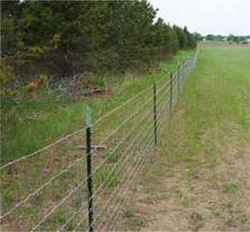Measuring plot boundaries is important for several reasons, such as selling a property, installing hedges and constructing fences. But when it comes to measuring boundaries for fencing, determining where your land ends and someone else's begins is not the easiest, most clear-cut task. However, there are a few techniques you can use when measuring boundaries for fencing.

Boundary Measuring Materials
There are a few, simple materials you will need for measuring boundaries for fencing. These materials are items such as:
* Land Records
* Surveyor's Measuring Tape
* Wood Stakes
* Shovel
* Metal Detector.
Surveying and Marking Your Property Boundaries
The first step to properly measuring boundaries for fencing is to walk around the property. Scope out objects like corner boundary poles as well as tree lines, existing fences and other visual markers. If you cannot find any visual markers, search for boundary pins located in the ground. Many times, surveyors will put metal stakes or pins in the ground to mark corner boundaries. Use your metal detector to locate these pins.
Sometimes, you will have to dig in order to find these pins. Carefully place a wooden stake on each pin. The stakes will serve as more clear visual markers. You will need to measure the distance from one stake to the next with your surveyor's measuring tape. Keep a note of each measurement.
If you do not find any visual markers or pins, review the property records or land deed. These documents are stored at the land office in your county. In these records, you will find information about past surveys, legal descriptions and property size and shape. This information can help you when measuring boundaries for fencing.
Homeowner's Associations and Local Fencing Ordinances
No matter what, measuring boundaries for fencing is an essential part of constructing a fence on your property line. If you neglect to measure beforehand, you risk upsetting the owners of the adjacent plot of land. And in most cases, you will be forced to tear down and move the fence. In addition to boundary measurements, you will need to know the measurement of the fence line. This information will help you determine the amount of materials you need to buy and subsequently, the money you will have to spend.
And above all else, you will need to find out the rules and regulations of your Homeowner's Association, or HOA, and any local governing ordinances. Sure, measuring boundaries for fencing is important. However, these measurements are fruitless if you are not meeting local codes.
Utility Fence Markings
If a construction project requires ground digging, the utility companies will need to get involved. So contact the gas company and other utilities in your area so they can mark the property's gas and utility lines. Any cables and lines that are buried must be identified before you can dig for fence posts. And if the utility lines are located in the area where you plan to build a fence, you have no choice but reevaluate, readjust and remeasure your fencing plans.
